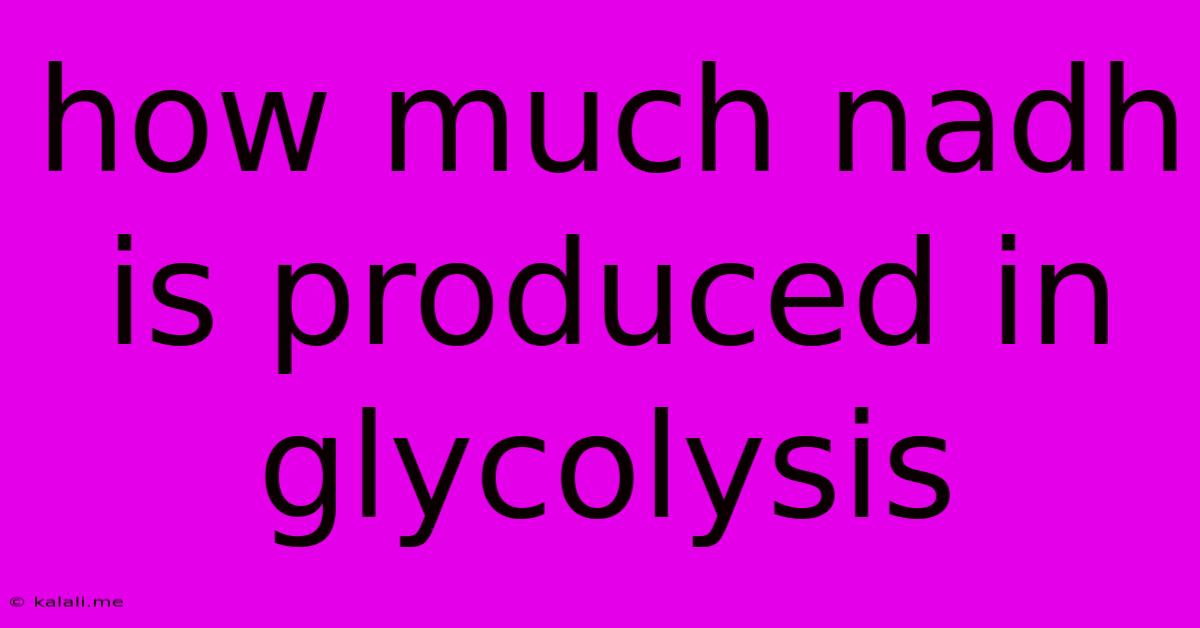How Much Nadh Is Produced In Glycolysis
Kalali
May 09, 2025 · 3 min read

Table of Contents
How Much NADH is Produced in Glycolysis? A Detailed Look at Energy Production
Glycolysis, the first stage of cellular respiration, is a crucial metabolic pathway that breaks down glucose into pyruvate. This process is vital for generating energy, even in the absence of oxygen. A key component of glycolysis is the production of NADH, a crucial electron carrier involved in ATP synthesis. But exactly how much NADH is produced during glycolysis? Let's delve into the details.
Understanding Glycolysis and NADH's Role
Glycolysis is a ten-step process occurring in the cytoplasm of cells. It doesn't require oxygen (anaerobic) and ultimately yields a net gain of two ATP molecules per glucose molecule. Beyond ATP, it also produces two molecules of pyruvate and, importantly, two molecules of NADH. This NADH plays a vital role in subsequent stages of cellular respiration, particularly oxidative phosphorylation, where it contributes significantly to ATP production. Understanding the exact yield of NADH is crucial for comprehending the overall energy efficiency of cellular metabolism.
The NADH-Producing Steps in Glycolysis
NADH production in glycolysis isn't a single event; rather, it's linked to specific enzymatic reactions within the pathway. The two NADH molecules are generated during the oxidation steps of glyceraldehyde-3-phosphate (G3P). Specifically:
- Glyceraldehyde-3-phosphate dehydrogenase (GAPDH) catalyzes the oxidation of G3P. In this reaction, two molecules of G3P (resulting from the earlier cleavage of fructose-1,6-bisphosphate) are oxidized, each yielding one molecule of NADH. This is a critical redox reaction, meaning electrons are transferred from G3P to NAD+, reducing it to NADH.
Why is the NADH Yield Crucial?
The two NADH molecules produced in glycolysis represent a significant portion of the total NADH generated during glucose metabolism. These NADH molecules are transported into the mitochondria, where they donate their high-energy electrons to the electron transport chain (ETC). The ETC utilizes these electrons to pump protons across the mitochondrial membrane, establishing a proton gradient. This gradient drives ATP synthase, generating a substantial amount of ATP through oxidative phosphorylation.
Factors Affecting NADH Production
While glycolysis typically produces two NADH molecules per glucose molecule, several factors can influence this yield:
- Enzyme activity: The activity levels of enzymes involved in glycolysis, particularly GAPDH, can affect NADH production. Factors influencing enzyme activity include temperature, pH, and the presence of inhibitors or activators.
- Metabolic conditions: Cellular conditions like oxygen availability and the presence of other metabolic substrates can influence the rate and efficiency of glycolysis and, consequently, NADH production. For example, under anaerobic conditions, the NADH produced in glycolysis may be used in fermentation pathways instead of oxidative phosphorylation.
In Summary: The Key Takeaway
In conclusion, glycolysis produces two molecules of NADH per glucose molecule. This seemingly modest yield plays a crucial role in the overall energy output of cellular respiration, contributing substantially to the overall ATP production through its involvement in oxidative phosphorylation. Understanding this fundamental aspect of glycolysis is essential for comprehending the complexities of cellular energy metabolism. Further exploration into the intricacies of the electron transport chain and ATP synthesis can provide a more complete understanding of how this NADH contributes to the cell's energy needs.
Latest Posts
Latest Posts
-
Unit Of Permittivity Of Free Space
May 09, 2025
-
51 Out Of 75 As A Percentage
May 09, 2025
-
Direction Of The Rotation Of The Earth
May 09, 2025
-
What Is 12 5 As A Mixed Number
May 09, 2025
-
How To Calculate Molarity From Titration
May 09, 2025
Related Post
Thank you for visiting our website which covers about How Much Nadh Is Produced In Glycolysis . We hope the information provided has been useful to you. Feel free to contact us if you have any questions or need further assistance. See you next time and don't miss to bookmark.